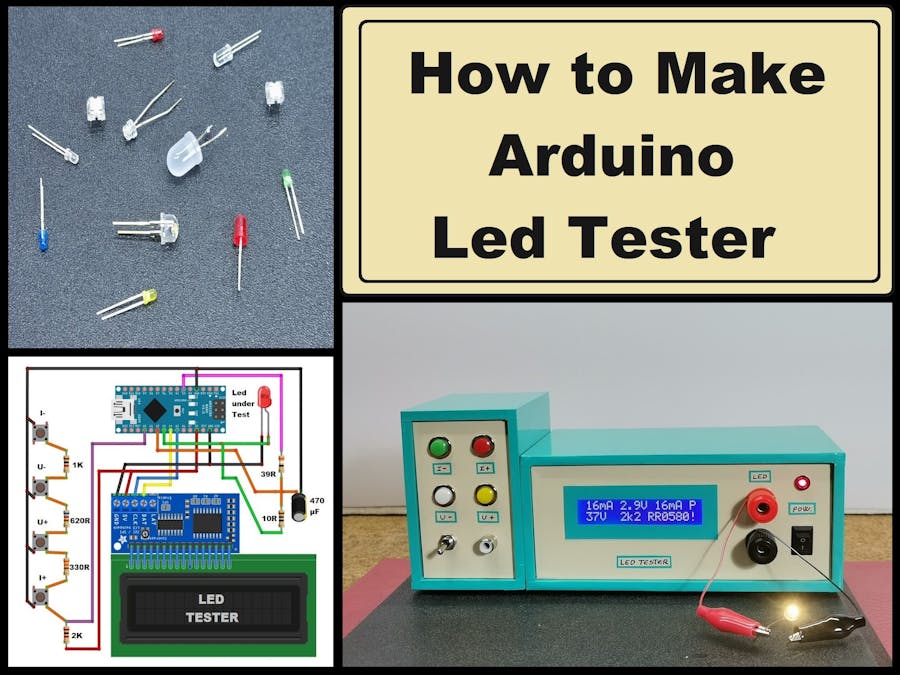/*
Arduino LED Tester
DPIN--39R--+--10R---TESTLED---GND
| | |
470u ATOP ABOT
|
GND
Measures LED characteristics by charging up the cap to deliver target current and find forward voltage
From target current, we can calculate R to be used with a design supply voltage and a matching part number.
*/
#include <Wire.h>
#include <LiquidCrystal_I2C.h>
//lcd update interval
#define LCDINT 500
//key check interval
#define KEYINT 200
//pin for buttons
#define KEYPIN A0
//button constants
#define btnRIGHT 6
#define btnUP 5
#define btnDOWN 4
#define btnLEFT 3
#define btnSELECT 2
#define btnNONE (-1)
LiquidCrystal_I2C lcd(0x27,16,2); // set the LCD adress
//Globals for display
long itest=10; //test current, in mA
long vset =14000; //display voltage in mV
long vled,vrr,irr,pset; //LED voltage, Resistor voltage, resistor current, display power
//resistors in Jaycar 1/2 W range, part nos start at RR0524 for 10R
#define RCOUNT 121
long rvals[]={10,11,12,13,15,16,18,20,22,24,27,30,33,36,39,43,47,51,56,62,68,75,82,91,100,110,120,130,150,160,180,200,220,240,270,300,330,360,390,430,470,510,560,620,680,750,820,910,1000,1100,1200,1300,1500,1600,1800,2000,2200,2400,2700,3000,3300,3600,3900,4300,4700,5100,5600,6200,6800,7500,8200,9100,10000,11000,12000,13000,15000,16000,18000,20000,22000,24000,27000,30000,33000,36000,39000,43000,47000,51000,56000,62000,68000,75000,82000,91000,100000,110000,120000,130000,150000,160000,180000,200000,220000,240000,270000,300000,330000,360000,390000,430000,470000,510000,560000,620000,680000,750000,820000,910000,1000000};
long lastlcd=0; //time of last lcd update
long lastkey=0; //time of last key check
int lcdflash=0; //lcd flashing phase variable
long pdes;
long rval; //calculated resistor value for display
long rindex; //index of selected resistor in rvals[]
int pwmout=0; //pwm output of current driver
int rvalid=0; //flag if resistor value is valid
//pins for test interface
#define ATOP A2
#define ABOT A3
#define DPIN 3
#define OSAMP 16
void setup() {
Serial.begin(9600);
// lcd.begin(16, 2); //lcd
lcd.begin();
lcd.clear();
lcd.backlight();
pinMode(DPIN,OUTPUT); //pwm pin
}
void loop() {
long atop,abot,arr; //analog sample values
rvalid=0; //set flag to not valid
atop=analogoversample(ATOP,OSAMP)/OSAMP;
abot=analogoversample(ABOT,OSAMP)/OSAMP;
arr=atop-abot; //this is the analog value across the 10R sense resistor
if(arr<0){arr=0;} //sanity check
vled=abot*5000/1023; //5000mV=1023 => voltage across LED
vrr=arr*5000/1023; //voltage across sense resistor
irr=vrr/10; //led and resistor current in mA (cos it's a 10R resistor)
if(irr<itest){pwmout++;if(pwmout>255){pwmout=255;}} //ramp up current if too low
if(irr>itest){pwmout--;if(pwmout<0){pwmout=0;}} //ramp down if too high
if(irr>24){pwmout=pwmout-5;if(pwmout<0){pwmout=0;}} //ramp down quick if too too high
if(irr>itest*3){pwmout=pwmout-5;if(pwmout<0){pwmout=0;}} //ramp down quick if too too high
analogWrite(DPIN,pwmout); //output new PWM
rval=(vset-vled)/itest; //mV/mV => ohms resistance of display resistor
for(int i=0;i<RCOUNT;i++){ //find next highest E24 value
if(rvals[i]>=rval){rindex=i;rval=rvals[rindex];i=RCOUNT+1;rvalid=1;}
}
if(abs(irr-itest)>(itest/5)+1){rvalid=0;} //has current settled within 20%?
if(vled>vset){rvalid=0;} //if vled>vset, no valid resistor exists
pset=0; //work out dissipation in ballast resistor if valid)
if(rvalid){pset=itest*itest*rval;} //this will be in microwatts (milliamps squared)
if(millis()-lastlcd>LCDINT){ //check if display due to be updated
lastlcd=millis();
dolcd(); //update display
lcdflash=1-lcdflash; //toggle flash variable
}
if(millis()-lastkey>KEYINT){ //check if keys due to be checked
lastkey=millis();
dobuttons();
}
delay(1);
} //end of loop
void dolcd(){
lcd.setCursor(0,0); //first line
//milliamps
if(lcdflash||rvalid){ //show if correct if on flashing phase
if(itest>9){lcd.write(((itest/10)%10)+'0');}else{lcd.write(' ');} //blank tens if zero
lcd.write((itest%10)+'0');
}
else{ //blank if not
lcd.write(' ');lcd.write(' ');
}
lcd.write('m');lcd.write('A');lcd.write(' ');
//VLED
lcd.write(((vled/1000)%10)+'0');
lcd.write('.');
lcd.write(((vled/100)%10)+'0');
lcd.write('V');lcd.write(' ');
//actual LED current
if(irr>9){lcd.write(((irr/10)%10)+'0');}else{lcd.write(' ');} //blank tens if zero
lcd.write((irr%10)+'0');
lcd.write('m');lcd.write('A');lcd.write(' ');
if((pset>499999)&&(lcdflash)){lcd.write('P');}else{lcd.write(' ');} //flash P if power above 1/2 watt
lcd.setCursor(0,1); //second line
//
if(vset>9999){lcd.write(((vset/10000)%10)+'0');}else{lcd.write(' ');} //tens of vset, blank if zero
lcd.write(((vset/1000)%10)+'0'); //units of vset
lcd.write('V');lcd.write(' ');
if(rvalid){
lcdprintrval(rval); //resistor value (4 characters)
lcd.write(' ');
lcdprintpartno(rindex); //resistor part no (6 characters)
if(pset>499999){lcd.write('!');}else{lcd.write(' ');} //show ! if power above 1/2 watt
}else{
lcd.write(' ');
lcd.write('-');
lcd.write('-');
lcd.write('-');
lcd.write(' ');
lcd.write('-');
lcd.write('-');
lcd.write('-');
lcd.write('-');
lcd.write('-');
lcd.write('-');
lcd.write(' ');
}
}
void lcdprintpartno(int index){
//part number
lcd.write('R');
lcd.write('R');
lcd.write('0');
lcd.write((((index+524)/100)%10)+'0'); //part no's start at RR0524 for 10R
lcd.write((((index+524)/10)%10)+'0');
lcd.write((((index+524))%10)+'0');
}
void lcdprintrval(long rval){ //print a value in 10k0 format, always outputs 4 characters
long mult=1;
long modval;
if(rval>999){mult=1000;}
if(rval>999999){mult=1000000;}
modval=(10*rval)/mult; //convert to final format, save a decimal place
if(modval>999){ //nnnM
lcd.write(((modval/1000)%10)+'0');
lcd.write(((modval/100)%10)+'0');
lcd.write(((modval/10)%10)+'0');
lcdprintmult(mult);
}else{
if(modval>99){ //nnMn
lcd.write(((modval/100)%10)+'0');
lcd.write(((modval/10)%10)+'0');
lcdprintmult(mult);
lcd.write(((modval)%10)+'0');
}else{ //_nMn
lcd.write(' ');
lcd.write(((modval/10)%10)+'0');
lcdprintmult(mult);
lcd.write(((modval)%10)+'0');
}
}
}
void lcdprintmult(long mult){ //helper function to print multiplier
switch (mult){
case 1: lcd.print('R');break;
case 1000: lcd.print('k');break;
case 1000000: lcd.print('M');break;
default: lcd.print('?');break;
}
}
int read_LCD_buttons(){
int adc_key_in = 0;
adc_key_in = analogRead(KEYPIN); // read the value from the sensor
delay(5); //switch debounce delay. Increase this delay if incorrect switch selections are returned.
int k = (analogRead(KEYPIN) - adc_key_in); //gives the button a slight range to allow for a little contact resistance noise
if (5 < abs(k)) return btnNONE; // double checks the keypress. If the two readings are not equal +/-k value after debounce delay, it tries again.
// my buttons when read are centered at these valies: 0, 144, 329, 504, 741
// we add approx 50 to those values and check to see if we are close
if (adc_key_in > 1000) return btnNONE; // We make this the 1st option for speed reasons since it will be the most likely result
if (adc_key_in < 50) return btnRIGHT;
if (adc_key_in < 195) return btnUP;
if (adc_key_in < 380) return btnDOWN;
if (adc_key_in < 555) return btnLEFT;
if (adc_key_in < 790) return btnSELECT;
return btnNONE; // when all others fail, return this...
}
void dobuttons(){ //updates variables. debounces by only sampling at intervals
int key;
key = read_LCD_buttons();
if(key==btnLEFT){itest=itest-1;if(itest<1){itest=1;}}
if(key==btnRIGHT){itest=itest+1;if(itest>20){itest=20;}}
if(key==btnUP){vset=vset+1000;if(vset>99000){vset=99000;}}
if(key==btnDOWN){vset=vset-1000;if(vset<0){vset=0;}}
}
long analogoversample(int pin,int samples){ //read pin samples times and return sum
long n=0;
for(int i=0;i<samples;i++){
n=n+analogRead(pin);
}
return n;
}














Comments
Please log in or sign up to comment.